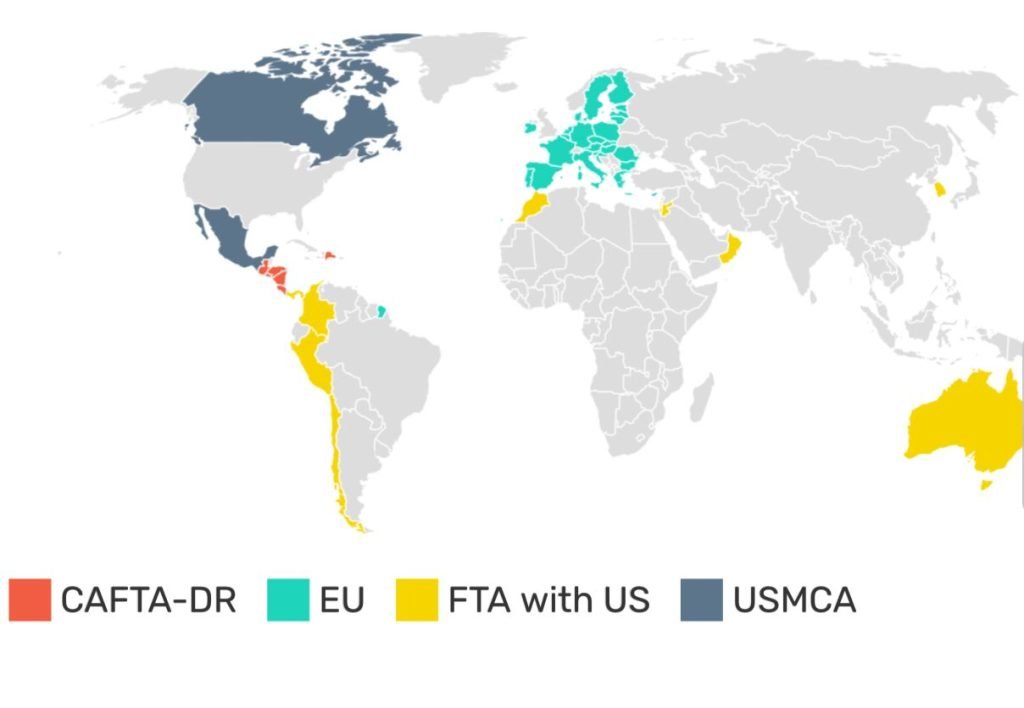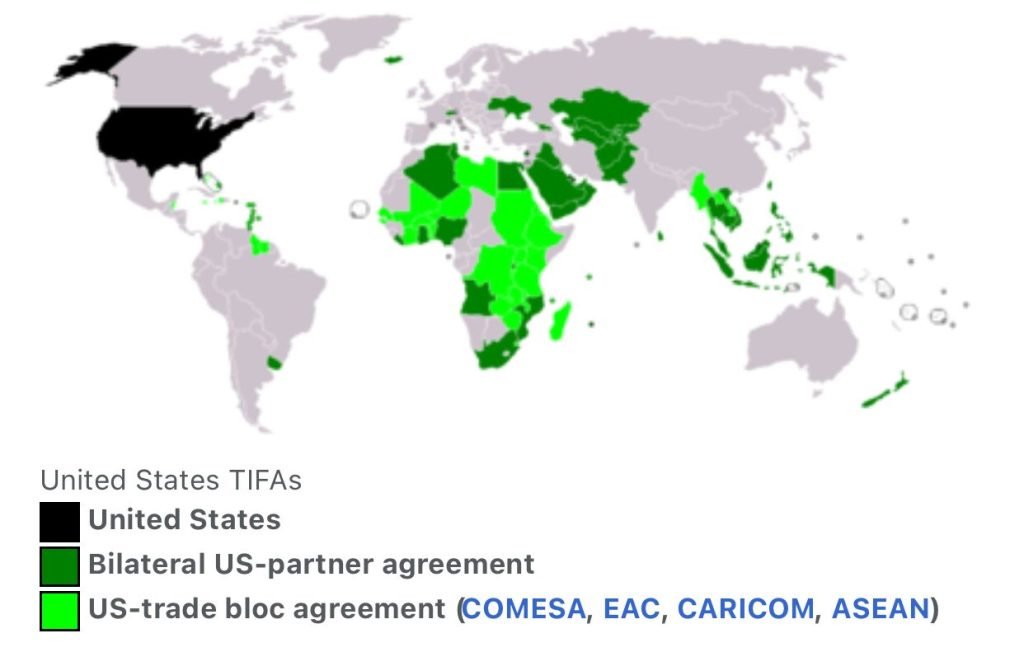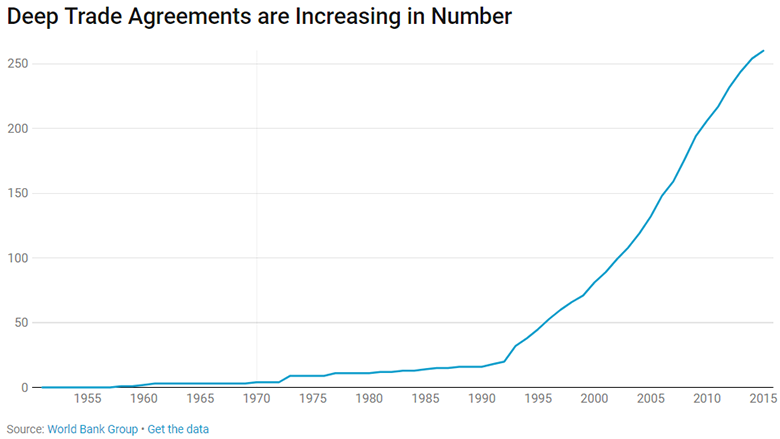Trade Agreements are contractual arrangements between states governing their trade relations. A trade agreement is formed when two or more countries reach an agreement on the terms of their trade.
Trade agreements often help countries augment their economies and help lay the foundation for creating opportunities for business in the global markets. It can also be regarded as economic integration.
Moreover, trading agreements determine the export and import tariffs. More or less, every trade deal has an impact on international trade.
Most nations impose unilateral trade restrictions of various kinds, such as tariffs, non-tariff barriers, and outright bans. One way to lower these barriers and thereby permit all parties to benefit from increasing commerce is through trade agreements.
Why are countries involved in Trade Agreements?
The most conventional purpose assumed to underlie a country’s participation in any trade negotiation is the idea that through reciprocal exchanges of concessions on trade barriers, there will be advances in market access from which all parties to the discussion will profit.
Likewise, another goal countries seek in trade agreements is the idea that trade treaties can strengthen and support domestic policy reform. By binding a nation to a masthead of an international trade treaty, any future rollback of domestic policy reform becomes more challenging to implement.
Furthermore, the ability of trade accords to facilitate security arrangements or strategic linkages among the integrating nations is another government priority while negotiating regional trade agreements.
Categories of Trade Agreements
Trade agreements assume three different categories:
Unilateral Trade Agreement
A unilateral trade agreement is a treaty that a nation imposes without considering the perspectives of other countries. It solely favors one nation. Since other countries have no alternative options, it is unilateral.
A unilateral trade preference is defined similarly by the World Trade Organization. It happens when one country implements a trade policy that isn’t reciprocated by another. For instance, it occurs when a nation places a trade restriction, like a tariff, on all imports.
Moreover, the United States and other developed countries only do this as a type of foreign aid to bolster vital industries in emerging markets that are too tiny to pose a threat.
Under the Generalized System of Preferences, the US has unilateral trade policies. That’s where the developed countries offer favorable import tariffs to goods from developing nations.
The GSP offers developing countries the chance to expand their economies through trade and reduce poverty. The GSP benefits developing countries by reducing the price of their goods in the United States, increasing demand, and boosting the Beneficiary Development Countries’ (BDCs) economy.
Furthermore, the US GSP grants duty-free status for 5,000 imports from 120 nations, including 43 of the Least Developed BDCs. Few among them are Bangladesh, Afghanistan, Bhutan, Cambodia, Nepal, and Yemen.
Bilateral Trade Agreement
A bilateral trade agreement grants two countries preferential trading status. The expansion of trade and the economy is facilitated by granting access to one another’s markets. The terms of the agreement provide parity and standardize corporate practices.
To increase commercial opportunities, both nations concur to wind down trade regulations. They guarantee each other favored trade status and lower tariffs. The sticking point typically centers around key protected or government-subsidized domestic industries.
The largest bilateral trade agreement ever signed was between the European Union and Japan on July 17, 2018. It lowered or eliminated tariffs on most of the $152 billion traded goods. The treaty came into implementation in 2019 after its ratification.
Additionally, the United States has bilateral trade pacts with 12 countries. A few include Australia, Bahrain, Chile, Colombia, Israel, and Peru.
Multilateral Trade Agreement
Multilateral trade agreements are commerce treaties involving three or more countries. The agreements lower tariffs and simplify the import and export processes for companies.
However, they are challenging to negotiate because they are spread over many states.
Multilateral accords have enormous power once they are negotiated. They provide signatories with a stronger competitive edge because they span a wider geographic area.
Additionally, all states grant one another the most favored nation designation, which offers the best mutual trade terms and lowest tariff.
Multilateral trade agreements are usually between countries with common geographical regions. The North American Free Trade Agreement (NAFTA), approved on January 1, 1994, was the greatest multilateral trade agreement. NAFTA quadrupled trade between the United States, Canada, and Mexico from 1993 to 2018.
Under President Donald Trump, the US-Mexico-Canada Agreement (USMCA), a new trade pact between the three nations, was negotiated in 2020.
Nevertheless, multilateral trade agreements can also be international. The General Agreement on Trade and Tariffs (GATT), negotiated between 153 countries after World War II, is perhaps the most successful international trade agreement.
Types of Trade Agreements
Various trade agreements depend on the conditions agreed upon by the participating bodies.
1. Free Trade Agreement (FTA)
A Free Trade Agreement is one in which two or more states concur to grant the partner nation preferential trading terms, tariff concessions, etc. It is more extensive than a preferential trade agreement because the negotiating nations maintain a list of goods and services for which the FTA’s rules do not apply.
Free Trade Agreement negates trade protectionism and isolationism and promotes trade liberalization.
The United States has several free trade agreements in force. These include multi-nation agreements like the Central American Free Trade Agreement (CAFTA), which encompasses most of the Central American countries, and the North American Free Trade Agreement (NAFTA), which covers the US, Canada, and Mexico.

The United States has 14 FTAs in force with 20 countries that build on the foundation of the WTO Agreement, providing even more protections and rights to U.S. businesses; and
Bilateral Investment Treaties (BITs) help protect private investment, develop market-oriented policies in partner countries, and promote U.S. exports.
Also read: AfCFTA to Stimulate Free Trade in Africa
Preferential Trade Agreement (PTA)
A preferential Trade Agreement between two or more partners gives a preferential right of entry to certain products. This is performed by lowering taxes on a predetermined number of tariff lines.
In this case, a positive list—a list of the products for which the two parties have agreed to grant preferred access is maintained. Potentially, in a PTA, some products’ tariffs could even be eliminated.
A free trade area is a preferential trade area with an expanded depth and range of tariff reductions. Advanced varieties of a PTA include all free trade zones, customs unions, common markets, and economic and monetary unions.
India has signed a PTA with Afghanistan. Moreover, Economic Cooperation Organization (ECO) is a multilateral preferential trade agreement.
Trade and Investment Framework Agreement (TIFA)
Framework Agreement principally defines the scope and orientation of the proposed agreement between the trading partners. It presents a few new discussion areas and establishes the time frame for future liberalization.
TIFA is a framework for boosting commerce and settling unresolved international conflicts. TIFAs are frequently seen as an essential step in establishing Free Trade Agreements.

The US and ASEAN concluded the U.S.-ASEAN Trade and Investment Framework Arrangement (TIFA) in 2006. Since then, the two countries have been working to strengthen their trade and investment links and further ASEAN regional economic integration.
In 2009, the US stepped up its efforts under the TIFA, providing senior ASEAN officials with various ambitious proposals to be followed by the TIFA work plan. These projects provide tangible outcomes in several fields, such as trade facilitation, logistics, the digital economy, trade finance, and trade and the environment.
4. Regional Trade Agreement (RTA)
Regional Trade Agreement is a trading pact signed between two or more nations to promote the free flow of goods and services across their borders. The pact includes internal regulations that the member nations abide by among themselves. There are external regulations in place that the members abide by when interacting with non-member nations.
Preferential and Free trade areas are the different types of Regional Trade Agreements. The North American Free Trade Agreement (NAFTA), Central American Free Trade Agreement (CAFTA-DR), European Union (EU), and Asia-Pacific Economic Cooperation (APEC) are a few examples of regional trade accords.

Role of WTO in Trade Agreements
Agreements require assistance if they transcend the regional level. At that time, the World Trade Organization intervenes. The organization works to negotiate and uphold international trade agreements.
The WTO currently enforces the General Agreement on Tariffs and Trade. GATT was a free trade pact that reduced tariffs and boosted global trade.
Between January 1, 1948, and January 1, 1995, the GATT, the first global multilateral free trade agreement, governed a significant chunk of world trade. The agreement ended when the more robust WTO replaced it.
Besides, The Doha Trade Agreement nearly guaranteed global free trade. If successful, it would have reduced tariffs across the board for all WTO members.
Effects of Trade Agreements
Trade Agreements incorporate both pros and cons. The Merits of trade agreements include removal of disputes, reduced tariffs, expanded export markets, specialization of labor and capital, foreign employment and economic growth, increased production, and consumer satisfaction.
However, by removing tariffs, the domestic industries suffer. Also, increased domestic instability from international trade cycles, as economies become dependent on global markets. Moreover, trade agreements often force a trade-off between companies and consumers.
How do countries benefit or detriment from trade agreements?
The countries bonded by trade agreements reap several benefits. Such bilateral or regional agreements can encourage additional trade between the contracting parties. Moreover, if multilateral discussions are unsuccessful, it might potentially speed up global trade liberalization.
In addition, these agreement proponents refer to the process of countries being pushed to lower trade barriers to compete with one another as “competitive liberalization.”
For instance, the EU sought and ultimately struck a free-trade deal with Mexico soon after NAFTA came into effect to ensure that European exports would not face a competitive disadvantage in the Mexican market due to NAFTA.
The critics of bilateral or multilateral trade agreements argue that trade liberalization may undermine and supersede rather than support and enhance the multilateral WTO approach, which is favored for operating on a non-discriminatory basis globally.







